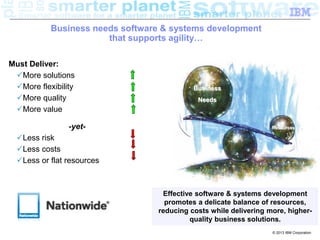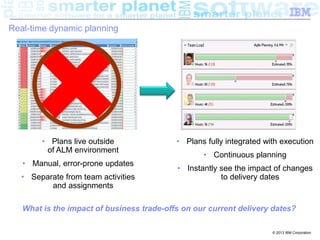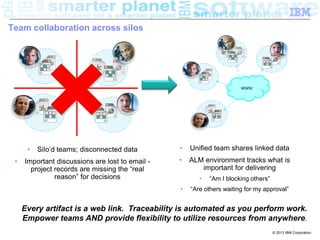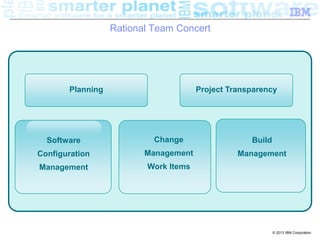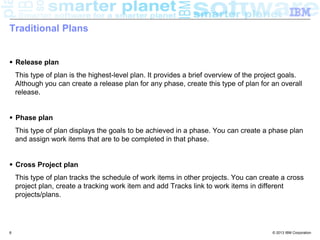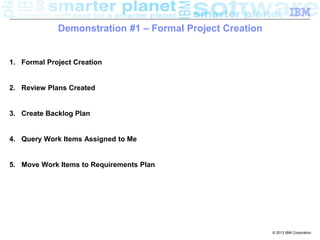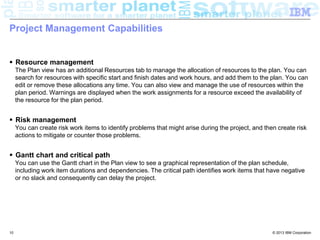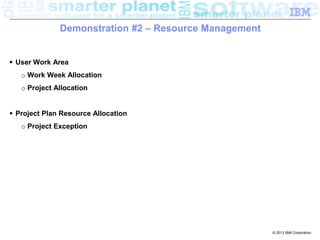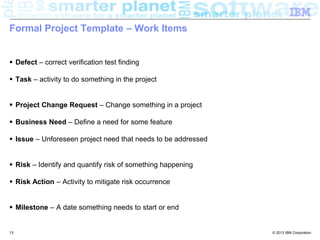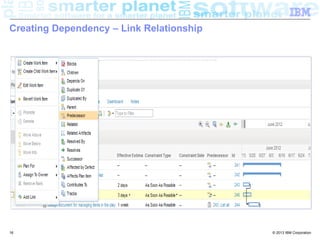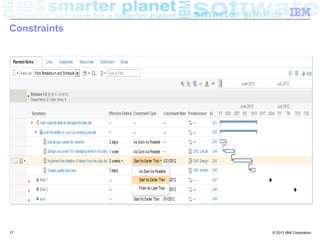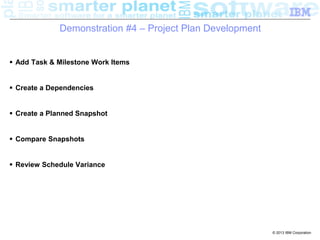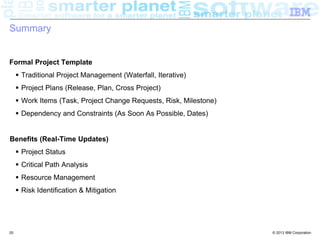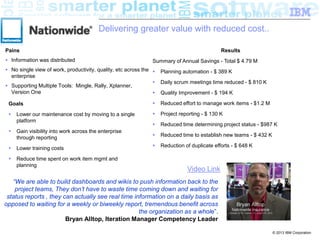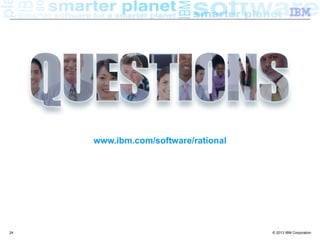4.3.2013 Tool Demo - Traditional Development RTC Planning In Context Collaboration
- 1. © 2013 IBM Corporation Rational Team Concert Traditional Development Real-Time Planning and In-Context Collaboration (Part 2: Demonstration) Don Cunningham, Rational CTP don.cunningham@us.ibm.com 3 – April – 2013
- 2. © 2013 IBM Corporation Business needs software & systems development that supports agility… Must Deliver: More solutions More flexibility More quality More value -yet- Less risk Less costs Less or flat resources Resources Business Needs Effective software & systems development promotes a delicate balance of resources, reducing costs while delivering more, higher- quality business solutions.
- 3. © 2013 IBM Corporation 3 Rational Team Concert is the core of our CLM Solution Improve productivity with an integrated ALM solution Rational Requirements Composer Rational Team Concert Rational Quality Manager IBM Rational Collaborative Lifecycle Management Solution Architect Analyst Developer Quality Professional Deployment Engineer Optimize your team through support of the 5 ALM Imperatives • Real-time planning • Lifecycle traceability • In-context collaboration • Development Intelligence • Continuous Improvement Get up and running quickly Extend as your needs evolve Support heterogeneous development across multiple platforms and technologies
- 4. © 2013 IBM Corporation Real-time dynamic planning 4 • Plans live outside of ALM environment • Manual, error-prone updates • Separate from team activities and assignments • Plans fully integrated with execution • Continuous planning • Instantly see the impact of changes to delivery dates What is the impact of business trade-offs on our current delivery dates?
- 5. © 2013 IBM Corporation Team collaboration across silos 5 • Silo’d teams; disconnected data • Important discussions are lost to email - project records are missing the “real reason” for decisions • Unified team shares linked data • ALM environment tracks what is important for delivering • “Am I blocking others” • “Are others waiting for my approval” www Every artifact is a web link. Traceability is automated as you perform work. Empower teams AND provide flexibility to utilize resources from anywhere.
- 6. © 2013 IBM Corporation Rational Team Concert Software Configuration Management Change Management Work Items Build Management Planning Project Transparency
- 7. © 2013 IBM Corporation Rational Team Concert Software Configuration Management Change Management Work Items Build Management Planning Project Transparency
- 8. © 2013 IBM Corporation Traditional Plans Release plan This type of plan is the highest-level plan. It provides a brief overview of the project goals. Although you can create a release plan for any phase, create this type of plan for an overall release. Phase plan This type of plan displays the goals to be achieved in a phase. You can create a phase plan and assign work items that are to be completed in that phase. Cross Project plan This type of plan tracks the schedule of work items in other projects. You can create a cross project plan, create a tracking work item and add Tracks link to work items in different projects/plans. 8
- 9. © 2013 IBM Corporation Demonstration #1 – Formal Project Creation 1. Formal Project Creation 2. Review Plans Created 3. Create Backlog Plan 4. Query Work Items Assigned to Me 5. Move Work Items to Requirements Plan
- 10. © 2013 IBM Corporation Project Management Capabilities Resource management The Plan view has an additional Resources tab to manage the allocation of resources to the plan. You can search for resources with specific start and finish dates and work hours, and add them to the plan. You can edit or remove these allocations any time. You can also view and manage the use of resources within the plan period. Warnings are displayed when the work assignments for a resource exceed the availability of the resource for the plan period. Risk management You can create risk work items to identify problems that might arise during the project, and then create risk actions to mitigate or counter those problems. Gantt chart and critical path You can use the Gantt chart in the Plan view to see a graphical representation of the plan schedule, including work item durations and dependencies. The critical path identifies work items that have negative or no slack and consequently can delay the project. 10
- 11. © 2013 IBM Corporation Demonstration #2 – Resource Management User Work Area o Work Week Allocation o Project Allocation Project Plan Resource Allocation o Project Exception
- 12. © 2013 IBM Corporation Rational Team Concert Software Configuration Management Change Management Work Items Build Management Planning Project Transparency
- 13. © 2013 IBM Corporation Formal Project Template – Work Items Defect – correct verification test finding Task – activity to do something in the project Project Change Request – Change something in a project Business Need – Define a need for some feature Issue – Unforeseen project need that needs to be addressed Risk – Identify and quantify risk of something happening Risk Action – Activity to mitigate risk occurrence Milestone – A date something needs to start or end 13
- 14. © 2013 IBM Corporation Demonstration #3 – Project Plan Development Review Work Items Created Create Risk & Risk Action Work Items Create Risk Parent – Child Relationship
- 15. © 2013 IBM Corporation Dependencies and Constraints Dependencies Finish-to-start Constraints As soon as possible Start no earlier than Finish no later than 15
- 16. © 2013 IBM Corporation Creating Dependency – Link Relationship 16
- 17. © 2013 IBM Corporation Constraints 17
- 18. © 2013 IBM Corporation Critical Path 18
- 19. © 2013 IBM Corporation Demonstration #4 – Project Plan Development Add Task & Milestone Work Items Create a Dependencies Create a Planned Snapshot Compare Snapshots Review Schedule Variance
- 20. © 2013 IBM Corporation Summary Formal Project Template Traditional Project Management (Waterfall, Iterative) Project Plans (Release, Plan, Cross Project) Work Items (Task, Project Change Requests, Risk, Milestone) Dependency and Constraints (As Soon As Possible, Dates) Benefits (Real-Time Updates) Project Status Critical Path Analysis Resource Management Risk Identification & Mitigation 20
- 21. © 2013 IBM Corporation Delivering greater value with reduced cost.. Pains Information was distributed No single view of work, productivity, quality, etc across the enterprise Supporting Multiple Tools: Mingle, Rally, Xplanner, Version One Goals Lower our maintenance cost by moving to a single platform Gain visibility into work across the enterprise through reporting Lower training costs Reduce time spent on work item mgmt and planning Results Summary of Annual Savings - Total $ 4.79 M Planning automation - $ 389 K Daily scrum meetings time reduced - $ 810 K Quality Improvement - $ 194 K Reduced effort to manage work items - $1.2 M Project reporting - $ 130 K Reduced time determining project status - $987 K Reduced time to establish new teams - $ 432 K Reduction of duplicate efforts - $ 648 K “We are able to build dashboards and wikis to push information back to the project teams, They don’t have to waste time coming down and waiting for status reports , they can actually see real time information on a daily basis as opposed to waiting for a weekly or biweekly report, tremendous benefit across the organization as a whole”. Bryan Alltop, Iteration Manager Competency Leader Video Link
- 22. © 2013 IBM Corporation For more information Find out more about Rational Team Concert • http://ibm.com/rational/rtc Explore Rational Team Concert tutorials, demos, downloads and other developer learning resources • https://jazz.net/projects/rational-team-concert/ Check for the latest RTC integrations • http://jazz.net/projects/rational-team-concert/integrations/ Watch a customer video testimonial (4 min) • http://www.mdma.tv/tc/short.html Try the RTC ROI Calculator • http://www.ibm.com/rational/rtc/roi
- 23. © 2013 IBM Corporation Presentation Resources The traditional scheduler in IBM Rational Team Concert 4.0 Traditional planning: Managing formal projects in Rational Team Concert 4.0 Microsoft Project integration with Rational Team Concert, Version 4.0 Sharoon Shetty Kuriyala, IBM Last updated: May 18, 2012 Build basis: Rational Team Concert 4.0 23
- 24. © 2013 IBM Corporation24 www.ibm.com/software/rational
- 25. © 2013 IBM Corporation25 © Copyright IBM Corporation 2011. All rights reserved. The information contained in these materials is provided for informational purposes only, and is provided AS IS without warranty of any kind, express or implied. IBM shall not be responsible for any damages arising out of the use of, or otherwise related to, these materials. Nothing contained in these materials is intended to, nor shall have the effect of, creating any warranties or representations from IBM or its suppliers or licensors, or altering the terms and conditions of the applicable license agreement governing the use of IBM software. References in these materials to IBM products, programs, or services do not imply that they will be available in all countries in which IBM operates. Product release dates and/or capabilities referenced in these materials may change at any time at IBM’s sole discretion based on market opportunities or other factors, and are not intended to be a commitment to future product or feature availability in any way. IBM, the IBM logo, Rational, the Rational logo, Telelogic, the Telelogic logo, and other IBM products and services are trademarks of the International Business Machines Corporation, in the United States, other countries or both. Other company, product, or service names may be trademarks or service marks of others. www.ibm.com/software/rational


